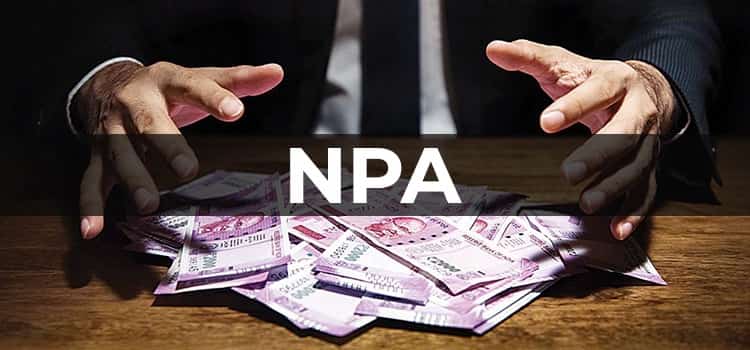Problem of NPA in Indian Economy
Posted On : June 16, 2021

Table of Contents
The most critical capacity of the monetary framework is the activation of the public investment funds and its allotment in various areas of the economy as speculation. The transformation of monetary reserve funds into venture capital is known as the interaction of capital arrangement in the economy. How the cycle of monetary intermediation (for example gathering dissipated investment funds and utilizing it to useful purposes) is completed will mirror the proficiency of the monetary foundations and their job in financial change of the country.
The resource quality was by all account not the only worry in the Indian financial area till 1991, yet it was primarily zeroed in on execution goals like opening wide organization/branches, advancement of rustic regions, need area loaning, higher business age, and so forth though the essential capacity of banks is to loan assets as credits to different areas like agribusiness, industry, individual credits, lodging advances and so on, however in the new past the banks have gotten mindful in expanding credits. The explanation being mounting NPA. Brokers are the caretaker and disbursers of the liquid capital of the country. Consequently, it is viewed as the main capacity of the financial framework is to prepare the reserve funds of the individual by tolerating stores from the public. The broker turns into the trustee of the excess adjusts of the general population. The NonPerforming Asset (NPA) idea is confined to advances, propels, and speculation. Up to a resource produces the pay anticipated from it and doesn't uncover any surprising danger other than typical business hazard, it is treated as performing resource, and when it neglects to create the expected pay it turns into a "Non-performing Asset". In an ensuing way, a long resource turns into a Non-Performing Asset (NPA) when it stops creating pay, i.e., interest, expenses, commissions, or some other levy for the bank for more than 90 days. A NPA is a development where installment of interest or reimbursement of portion on head or both remaining parts neglected any of the credit offices is to treat as past due when it stays neglected for 30 days past due date.
Origins of the NPA
A great deal of the credits presently delegated NPAs began during the 2000s when the economy was blasting and business viewpoint was positive. Enormous enterprises were allowed credits for projects dependent on the extrapolation of their new development and execution. With credits being accessible more effectively than previously, organizations became exceptionally utilized, suggesting that most financings were through outer borrowings as opposed to inward advertiser value. Be that as it may, as monetary development deteriorated following the worldwide monetary emergency of 2008, the reimbursement capacity of these enterprises diminished. This added to what exactly is presently known as India's Twin Balance Sheet issue, where both the financial area (that gives credits) and the corporate area (that takes and needs to reimburse these advances) have gone under monetary pressure. [1]
At the point when the venture for which the credit was taken begun failing to meet expectations, borrowers lost their ability to take care of the bank. The banks right now took to the act of 'evergreening', where new credits were given to certain advertisers to empower them to take care of their premium. This viably pushed the acknowledgment of these advances as non-performing to a later date, however didn't address the underlying drivers of their unbeneficial quality.
Further, as of late there have likewise been cheats of high value that have added to rising NPAs. Albeit the size of fakes comparative with the all-out volume of NPAs is generally little, these fakes have been expanding, and there have been no occurrences of high profile fraudsters being punished.
Securitization of Assets
The SARFAESI Act introduced securitization of assets by enabling the sale of NPA to ARC (Asset Restructuring Company). Section 13 of SARFAESI Act, 2002 explicitly offers right to the protected bank with the legitimate authority/force of extraordinary import, without making adequate responsibility system. The measures that can be taken the response by the got bank under Section 13(4) incorporate the ability to assume control over the administration of the matter of the borrower and tame any individual to deal with the got resources. There is a complete shortfall of any check against the maltreatment of any chance to control the property and business of the borrower in the hand of the bank. The bank and the director would without a doubt be in the situation of "trustees" while in charge and they ought to be dependent upon all polite and criminal ramifications for the penetrate of trust. [2]
Indian Parliament has corrected the Securitization and Reconstruction of Financial Assets and Requirement of Security Interests Act, 2002 (SARFAESI Act) and the Recovery of Debts Due to Banks and Financial Institutions Act, 1993 (DRT Act) in 2016. These alterations plan to make an empowering framework to emotionally manage focused on resources. It additionally gives more powers to the Reserve Bank of India (RBI) to manage resource reproduction organizations (ARCs). An ARC's essential objective is to oversee and to make beneficial those resources which have been failing to meet expectations, or then again which have been officially named NPA's. Selling pushed and NPA records to ARCs has been expanding since March 2014, Asa result, the administrative help reached out to banks under the Framework to Revitalize the Distressed Assets in the economic It is proposed to give RBI forces to review and assess ARCs and opportunity to eliminate the executive or any chief and select national bank authorities to the board. RBI will be engaged to force a punishment for rebelliousness with its orders, other than directing the expenses charged by these organizations to banks at the hour of getting such resources. [3]
The influence of IBC
The Insolvency and Bankruptcy Code, 2016 enacted by the Government of India mirrors a reasonable expectation to determine and rebuild awful obligations in a period-bound way and fitting escape clauses accessible to borrowers who have defaulted on their installments. Two separate councils are suggested - the National Company Law Tribunal (NCLT) for organizations and restricted risk association for firms, and the Debt Recovery Tribunal for people and organizations. The code enrolled the appropriate technique and instrument of managing focused on resources in a really encouraging manner.
One of the issues before the Hon'ble NCLAT on account of J.K Jute Mills Company Ltd. V. M/s. Surendra Trading Co. [4] was that as far as possible recommended in IBC, 2016 for conceding or dismissing a request or inception of indebtedness goal measure is required. The court grandly brought up the goal behind the time-frame endorsed under Section 7(5) and Section 9 (5) likewise Section 10(4), like Order VII Rule 1 of CPC is to forestall the postponement in hearing the removal of the cases. The bench held that “the time is the essence of the code and all the stakeholders, including the Adjudicating Authority are require to perform its jobs within the time prescribed under the code except in exceptional circumstances if the adjudicating authority for one or other good reason fails to do so.”
The law likewise cherishes a period where in the Committee of Creditor is required to investigations the records of the organization, hear rival proposition and decide on the issue. A Revival Plan is restricting on all loan bosses and partners if 75% of the Creditors Committee consents to it. On the other hand, if 75% of the Creditors Committee concludes that the intricacy of the case requires more opportunity for goal, a one-time expansion of 90 days is conceivable with the endorsement of the Mediating Authority. Though, if in 180 days no revival plan accomplishes the backing of 75% of banks, the firm goes into liquidation. In particular, it accommodates goal of indebtedness in a speedier and time-bound way, and furthermore indicates prioritization of repayments of obligations owed by a corporate account holder. [5]
On account of Sandeep Reddy and Anr. v. Jaycon Infrastructure Ltd [6] the inquiry under the watchful eye of the court was that whether NCLT has ability to choose an IRP, without acquiring ideas from IBBI all alone, and where the name of an IRP has likewise not been proposed by Operational Creditor in the application for CIRP. It was held that since the gatherings had resolved the questions and inception of goal measure u/S 9 of the code was not viable, taking into account presence of debates, NCLAT left the inquiry open concerning whether the NCLT had ability to select any individual voluntarily or not.
Conclusion
The lawful changes to check the NPAs (viz., BIFR/SICA, Lok Adalats, DRTs, OTS, SARFAESI and so on) yet, nothing has hit the imprint in handling NPAs. The adequacy of both DRT/Securitization act was tested and still hangs in situation, in numerous Indian cases the real situation of the defaulter was not decided. There ought to be a genuine crackdown on determined defaulters and their resources whether charged too banks ought to be announced as public resources and be arranged in a straightforward way, without major legitimate obstacles. Consequently, accordingly, there was a requirement for additional severe law to check the higher developing NPAs in the country which is straightforwardly hampering the development of the economy.
On the other hand, the Insolvency and Bankruptcy Code, 2016, is a reformist enactment that is planned to improve the effectiveness of indebtedness and chapter 11 procedures in India. The new enactment accommodates the early location of monetary trouble and a period-headed cycle for goal. Be that as it may, numerous features on the IBC's execution should be worked out in the guidelines, also, its prosperity will depend generally on the enlistment of indebtedness goal experts will arise with the time headed interaction for bankruptcy goal will be followed to by and by. The code significantly brought to a course the much-anticipated changes that necessities to be viewed in turning answers for the non-performing resources. The revisions are maybe the main arrangement of changes to the SARFAESI Act since its authorization in 2002. The Liquidation Code and the revisions to the SARFAESI Act together mirror an unmistakable administrative intent to plug any sort of loophole and stay inclined towards the creditor’s cause.
























